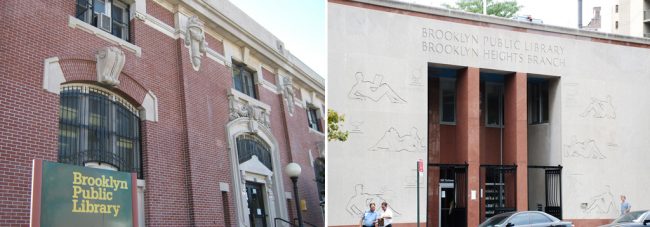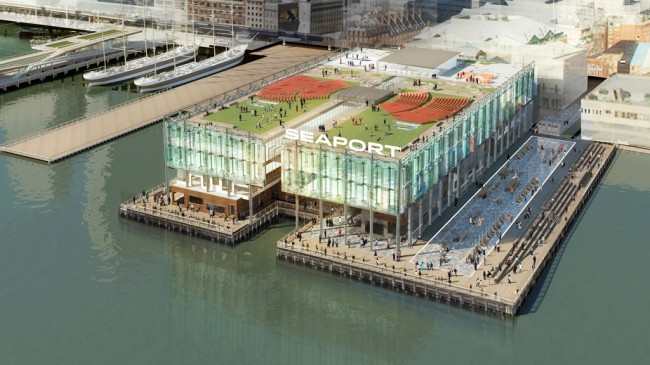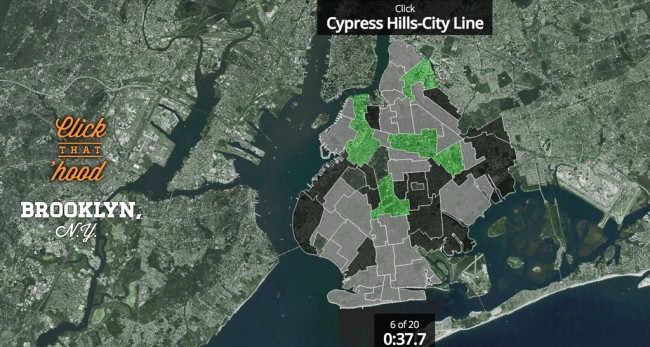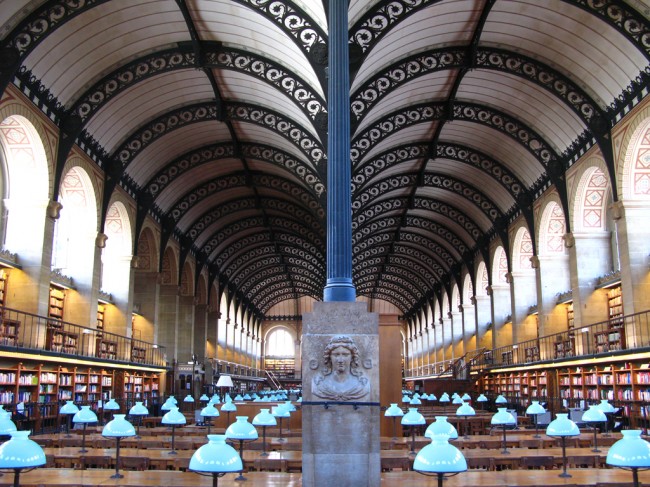
Celebrate ten years of Urban Omnibus and support ten more years of fresh, independent perspectives on citymaking with a donation today!
Celebrate ten years of Urban Omnibus and support ten more years of fresh, independent perspectives on citymaking with a donation today!

The land on which the Pacific and Brooklyn Heights branches of the Brooklyn Public Library sit will be sold to fund the library’s operations. | Images via Utopian Branch Library (l) and Adam Fagen (r)
PUBLIC FUNDING THROUGH REAL ESTATE
Selling real estate to plug budget shortfalls is becoming an increasingly common strategy in the city, according to The New York Times. Most recently, the Brooklyn Public Library announced a plan to sell the land under two branches in highly desirable areas. Developers would tear the branches down and include new library facilities as part of their private developments on the site. While the replacement branches would be built at no cost to the library system — and solve the looming problem of $9-11 million in needed repairs on these two branches alone — opponents of the plan worry about decreased service in the interim and loss of neighborhood civic landmarks. The funding model has also been embraced by the Department of Education, whose latest proposal would have three schools near Lincoln Center meeting the same (temporary) fate as the libraries. These plans come on the heels of the New York City Housing Authority’s (NYCHA) announcement of plans to develop luxury residential properties on “underutilized land” to fund much needed repairs in existing buildings, details of which were released on Wednesday.
THE FUTURE OF PENN STATION
With a City Planning Commission hearing on the land use permit that allows Madison Square Garden to operate on top of Penn Station set for April 10th, the debate over the future of Penn Station and MSG continues this week with architecture critic Michael Kimmelman, the Municipal Arts Society, and the Regional Plan Association urging the commission to give only a ten-year extension of the permit instead of the requested authorization to operate in perpetuity. The groups say that the ten-year extension will provide time for a reconsideration of MSG’s place atop the transit hub, which needs more space to accomodate the hundreds of thousands of passengers it serves daily, anticipated future ridership growth, and improvements to the current much maligned design.
HIDDEN HISTORY
The complex confluence of policy, relationships, money, and chance that has sculpted the present and past of New York is often hidden, forgotten, covered by layers of interpretation, or locked in an archive. This week, Narratively delves into five hidden histories of the city including a 1918 subway crash that reshaped New York’s transportation landscape, the once-public now off-limits observation decks of skyscrapers, and the grand but troubled United States-themed amusement park that once occupied Co-op City’s swath of Baychester, the Bronx.

A rendering of the Pier 17 of the future | Image via Howard Hughes
SEAPORT REDEVELOPMENT
Clearing its last major hurdle in the public review process, the City Council approved the redevelopment of the South Street Seaport’s Pier 17 on Wednesday, following a deal with developer Howard Hughes reached Tuesday. The deal pushes back the demolition and replacement of the current mall with a new retail complex to October, allowing current mall tenants the summer to try to recoup losses suffered due to Sandy. The plan now also calls for two food markets in the old Fulton Fish Market building and a neighboring space, though advocates for the public market on the site (including Robert LaValva, who told us about his vision for the market last summer) were disappointed by the size of the space offered. The deal also promises additional public space for the neighborhood, as the Council required that the new complex’s green roof be open and accessible to the public.
D+ FOR INFRASTRUCTURE
The annual release of the American Society of Civil Engineers’ (ASCE) Report Card for America’s Infrastructure has become a tradition in bemoaning the sorry state of our bridges, rails, and roads. Though still coming in at a worrisome D+ and requiring an additional $1.6 trillion of investment to rise to an acceptable level, this year’s report marks the first improvement in 15 years, from a D to a D+.
REDUCING THE WASTE STREAM
In contrast with much of Mayor Bloomberg’s environmental record, recycling rates have plummeted during his tenure, dropping from 35.1% in 2002 to 16.6% in 2012. The drop is largely attributed to a one-year suspension in recycling following 9/11 and the City’s suspension of glass and plastic recycling to save money from 2003-2004. Already trailing far behind the beacon cities of San Francisco and Portland, New York City — under the guidance of “recycling czar” Ron Gonen — is rolling out a new campaign to boost waste diversion by half through the installation of 1,000 new public recycling receptacles, a new pilot curbside organic waste program, and greater recycling capacity thanks to a new, state-of-the-art facility in Sunset Park, Brooklyn. Gonen hopes to save the city $60 million through new efforts, and plans to launch a public education campaign that will focus, in part, on the economics of waste. Private entities (like Compost for Brooklyn) are so far leading the way to increase composting, but a partnership between the Department of Sanitation, Build it Green! NYC, and Brooklyn Grange is already collecting organic waste for composting at the Broadway N/Q stop and several libraries, for use by the Grange’s farms in Queens.

Play the neighborhood identification game with Code for America’s Click that ‘Hood. | Image via Click that Hood
CLICK THAT ‘HOOD
Knowledge of the city’s layout, especially of the ever-shifting borders and names of neighborhoods, is a point of pride for many urbanites. Heighten your skills of neighborhood identification for your next friendly argument with Click That ‘Hood, a game developed by Code for America‘s 2013 Louisville fellowship team. Non-New Yorkers needn’t worry — players can choose from close to 50 cities, from Saskatoon to Szczecin.
SANDY UPDATES
Officials held the last of ten community outreach sessions this week — intended to generate ideas for how the city should protect itself for the next superstorm — and presented projects from around the world to spur discussion about resiliency. The sessions were held in waterfront neighborhoods battered by the storm, among them hard-hit Red Hook, where well known business like Fairway and Red Hook Lobster Pound are just now returning and bringing people back into the neighborhood. Despite flooding during Sandy, the City Council approved a 700-unit rental development along the Gowanus Canal over the objections of district Councilman Brad Lander. The plan altered previous designs to build closer to the canal’s edge and will put the lowest floor over ten feet above the floodplain indicated in new FEMA maps and all mechanical equipment on higher floors.

The reading room of the Bibliothèque Sainte-Geneviève in Paris, one of Henri Labrouste’s most lauded creations | Image via Paula Soler-Moya
EVENTS AND STUFF TO DO
LABROUSTE SYMPOSIUM
In conjunction with its exhibit Henri Labrouste: Structure Brought to Light, MoMA will host a day-long symposium on Thursday, March 28th, on the relevance of the 19th-century french architect’s “innovative use of materials and light in spaces of contemplation and public assembly” and its relevance to contemporary culture and architecture.
HIGH-RISE STORIES
As part of an interactive project exploring “the history and future of high-rise buildings and their relationship to issues of equity, segregation, and social responsibility in cities around the world,” The New York Times is inviting anyone to contribute photographs and accompanying stories that illustrate the experience of living in or around high-rises for possible inclusion in a documentary for its Op-Docs series. The project will consist of three additional documentaries sourced from the Times‘ archive, directed by Katerina Cizek, and produced as part of Highrise, a multi-year, many-media, collaborative documentary experiment at the National Film Board of Canada, that explores vertical living around the world.
DARKENED CITIES
From March 28th through May 4th, the Danziger Gallery will provide a look at cities as they would appear without light pollution obscuring the stars through the photography of Thierry Cohen. Darkened Cities, Cohen’s three-year project, in which he splices photographs of cities with photographs of constellations hovering above them but taken in places of atmospheric clarity at the same angle and equivalent latitude, seeks to question our manipulations of the planet and life cycles that block out this connection with nature in urban environments. (For more on the disappearance of the night sky in urban environments, look back at this interview with The City Dark filmmaker Ian Cheney.)
GOVERNORS ISLAND DESIGN COMPETITION
Warmer weather approaches, and Governors Island — with its large-scale installations and artist-designed mini-golf — will soon be open to the public once again. Though this summer’s main pavilion is already in the works, Figment is already looking ahead to 2014, accepting entries for next year’s City of Dreams Pavilion Design Competition. Registration is required by May 1st, and submissions, which should be “efficient and sustainable” and “consider the entire life cycle of building materials,” are due June 1st.
SQUIBB BRIDGE
Despite its stunning view of Brooklyn Bridge Park, the Brooklyn Heights Promenade has been separated from the new park since the first portion opened in 2010, requiring visitors to walk a steep and circuitous route around the Brooklyn Queens Expressway, to visit the waterfront. The connection between these two jewels of public space has become faster (supposedly) and stronger with the opening of the Squibb Bridge this week, directly connecting the two using trail bridge construction techniques (meaning the bridge bounces just noticeably as you cross). Take a stroll on the bridge this sunny weekend.
The Roundup keeps you up to date with topics we’ve featured and other things we think are worth knowing about.
The views expressed here are those of the authors only and do not reflect the position of The Architectural League of New York.